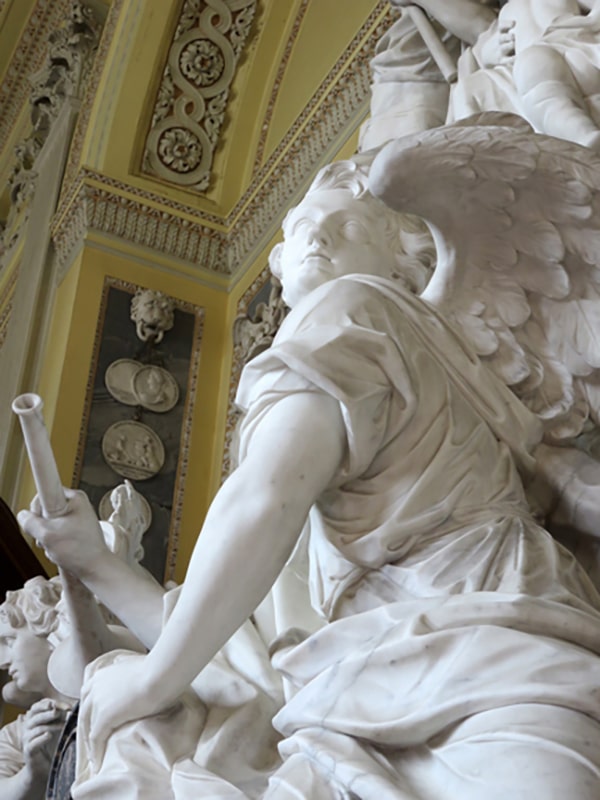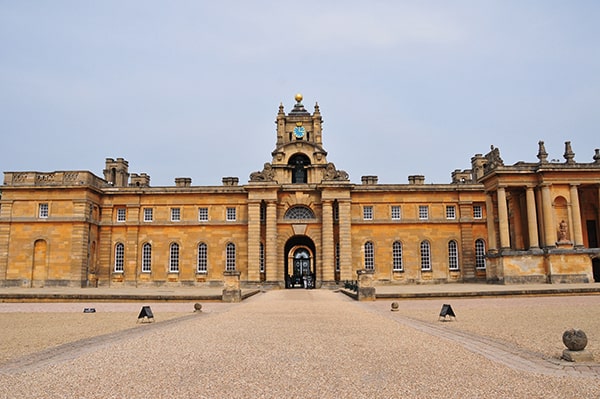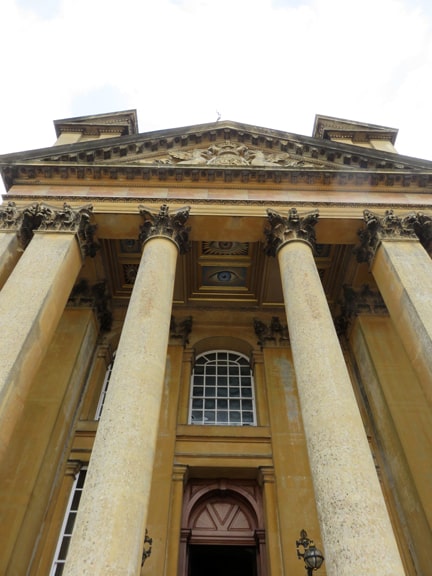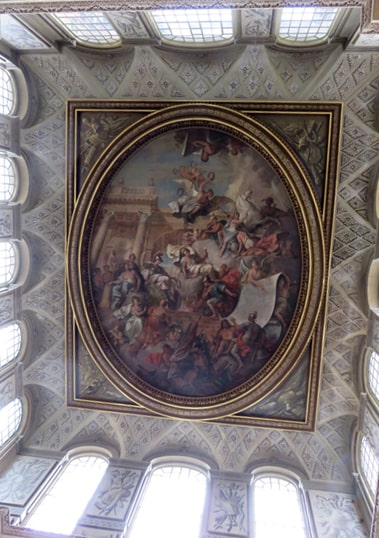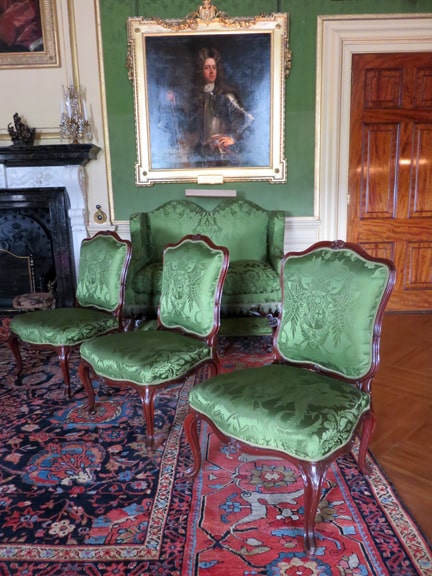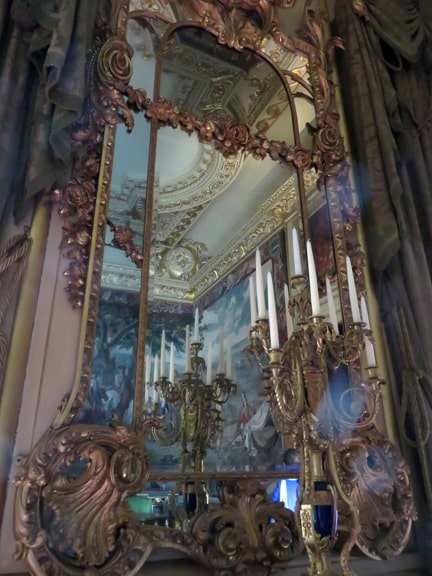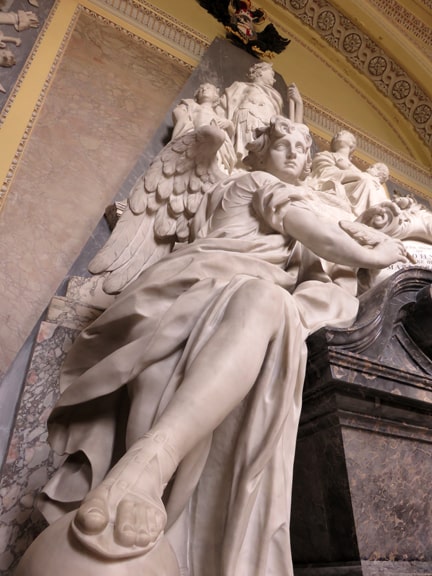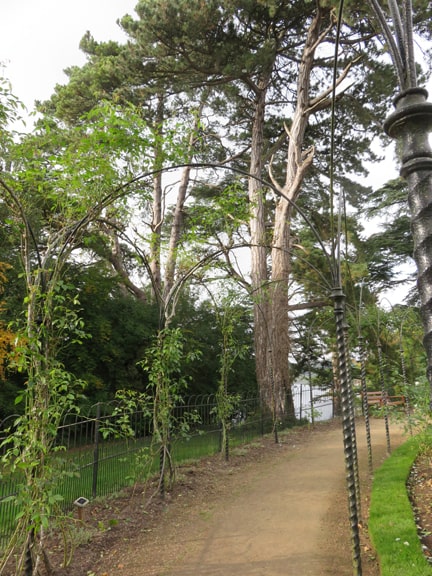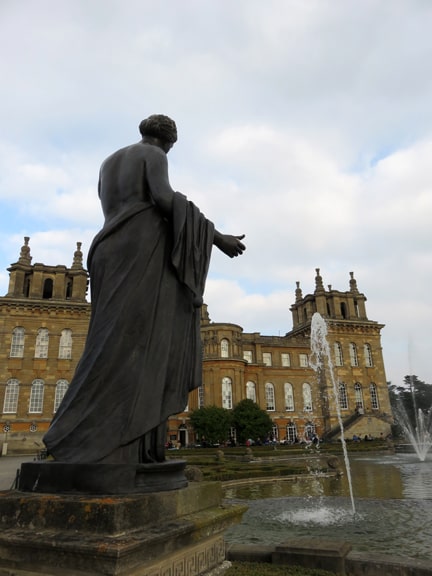|
The stunning interior of Blenheim Palace in Oxfordshire is matched by an impressive exterior and acres of natural beauty on the edge of the Cotswolds.
About Blenheim Palace
Located 63 miles from London and 10 miles from Oxford, Blenheim Palace is bigger than Buckingham Palace and is the only non-royal palace in England.
Blenheim Palace is designated as a World Heritage Site by UNESCO for its historical significance. Blenheim (pronounced “Ble-num”) is derived from Blindheim, a village in Bavaria, Germany, where The Battle of Blenheim took place in 1704. Queen Anne bestowed 2,000 acres in Oxfordshire to General John Churchill, the 1st Duke of Marlborough, for the military victory at Blenheim. A national monument and a family home, the house alone has 187 rooms and encompasses 7 acres. Blenheim Palace cost Parliament £240,000 with the Churchills contributing £60,000.
Visitors approach Blenheim Palace through a series of small arches.
In the Clock Tower, the clock hands on each face are gilded in 24-carat goldleaf. The Clock Tower’s three bells chime every quarter hour. The Clock Tower was made by Langley Bradley in 1710. Langley Bradley was Master of the Clockmakers Company and made the original clock (circa 1706) for St. Paul’s Cathedral in London.
The 1st Duke of Marlborough and The Battle of Blenheim
To honor the 1st Duke of Marlborough as a great warrior, the palace has columns, statues, and pillars, in the style of the Generals of the Roman Empire.
Today’s visitors see what 18th century visitors would see when they enter Blenheim Palace, a 64-foot-high Great Hall.
In the painting on the ceiling, The Duke of Marlborough presents his plan for The Battle of Blenheim to the female figure of Britannia who rewards him with a victor’s laurel crown. The Goddess Fame trumpets the Duke’s achievements, and Cleo, the Muse of History, records the year of the battle in her book. The Battle of Blenheim was fought on a single day in 1704. France, under King Louis XIV, had set its sights on the Spanish Empire, but Spain was part of The Grand Alliance with England. When France and its ally, Bavaria, moved to capture Vienna, The Duke of Marlborough, led the Allies on a 250-mile march, over 5 weeks, from The Netherlands to the Danube. At the end of the battle, the Allies had lost 4,500 men; the French and the Bavarians had lost 20,000 men.
Before he became The Duke of Marlborough, the 25-year-old John Churchill in this 1675 portrait was a Colonel known for his logistical and tactical abilities.
In the Green Writing Room is a framed note written by the 54-year-old General John Churchill after The Battle of Blenheim. Using a scrap of paper (a receipt of goods received for the troops), he wrote to his wife, Sarah, giving an account of the battle, so that she would relay the news to Queen Anne. (Sarah was a maid of honor to Queen Anne.) The note reads in part: “I have not time to say more, but beg you will give my duty to The Queen, and let her know her army has had a glorious victory.”
As a reward for this “glorious victory” at Blenheim, Queen Anne bestowed land in Oxfordshire to The Duke of Marlborough. Parliament authorized the building of a monument to celebrate the victory over France’s King Louis XIV. This monument became Blenheim Palace.
To demonstrate England’s victory over France, the architect, Sir John Vanbrugh wanted Blenheim to rival Versailles. Vanbrugh is said to have “refined” the Baroque style for Blenheim Palace, yet its decoration is still opulent and ornate.
Blenheim Palace and Sir Winston Churchill
In 1874, Winston Churchill was born at Blenheim Palace because his mother went into labor while at the palace. Sir Winston Churchill’s grave is located at St. Martin’s Church in Bladon (less than 2 miles from Blenheim Palace).
Blenheim Palace and the Vanderbilts
The portrait of Consuelo Vanderbilt – in youthful white and pink – reigns above the fireplace in the First State Room. In 1895, the 18-year-old Consuelo, an American heiress, was forced by her mother, Alva Vanderbilt, to marry the 9th Duke of Marlborough.
The Newport mansion built for Alva Vanderbilt, Marble House, is a “Stone Palace” that comes to life at Christmas.
The Blenheim Standard (the white cloth with three fleur-de-lis) hangs from the fireplace mantel. In lieu of rent, this standard is presented every year at Windsor Castle prior to the anniversary of The Battle of Blenheim.
If this “rent” is not paid, the title of Blenheim Palace would revert back to The Crown because it was built on land gifted by Queen Anne.
Looking down from a wall in the Red Drawing Room is a 1905 family portrait painted by John Singer Sargent.
The 5' 9" Consuelo Vanderbilt was taller than her husband, the 9th Duke of Marlborough. In the portrait, the height difference is disguised by painting Consuelo standing on a stair with her two sons. The bankrupt Duke had married Consuelo Vanderbilt to save Blenheim Palace. The couple divorced in 1921, and Consuelo married French aviator and industrialist, Jacques Balsan. Blenheim Palace Chapel
The self-guided tour of the Blenheim Palace interior ends in the chapel with its double staircase, plaster ceiling, and marble memorial to the 1st Duke of Marlborough. The white marble memorial cost £2,200 (£186,000 or $213,000 today).
The 1st Duke of Marlborough lived in Blenheim Palace for only 3 years. He died at the age of 72, before the chapel was finished. Upon his death, Sarah commissioned William Kent to design a memorial in the family chapel. Sarah survived her husband by 22 years; she died at the age of 84.
Because the chapel was finished years after the 1st Duke’s death, he was buried in Westminster Abbey when he died. After Sarah’s death, the Duke’s body was reinterred in the chapel beside her. On either side of the sarcophagus are History with her quill and Fame with her trumpet.
At the base of the marble memorial, the sarcophagus crushes the last enemy: envy.
Blenheim Palace Gardens
It was the 4th Duke of Marlborough who lived permanently at Blenheim Palace. The 4th Duke employed the landscape architect, Capability Brown, who preferred natural landscapes to formal gardens.
In 1817, the 4th Duke was succeeded by his eldest son who made changes to the Blenheim grounds with a number of varied plantings and a rose garden.
The beds of roses in The Rose Garden are arranged in a petal shape.
The Rose Garden is a circular walk with arched hoops to support climbing roses.
The formal gardens include the Upper Water Terraces. A statue of Venus – the Goddess of Love and the Guardian of Gardens – stands at each corner of the pool. On the outdoor terrace overlooking the pool, visitors can enjoy a light lunch.
Still privately owned by the descendants of the 1st Duke of Marlborough, Blenheim Palace receives tens of thousands of visitors each year. Events at Blenheim Palace include art exhibits, battle prom with fireworks, concerts, and Christmas lights. Turn your ticket into an Annual Pass to attend the flower show, food festival, or jousting tournament. Go to the Blenheim Palace website to learn more about visiting and exploring the palace. Comments are closed.
|
Fold GentlyPlaces unexpected. Bakes for home bakers. Books overlooked. Find your new favorite thing. |

